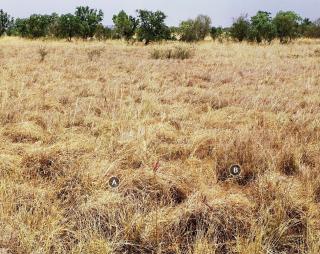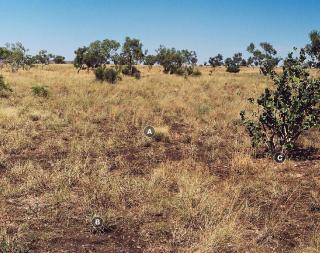Mitchell grass upland pastures
These pastures are part of the Kimberley 'black' soils group of pastures, and the perennial Mitchell grasses are the identifier grasses. Use the interactive key to pasture condition to help identify pasture type.
Pastoral value
Pastoral value is high when in good condition, although the uplands are slightly less productive than the alluvial plains. As Mitchell grass presence declines, pasture value also declines because the desirable grasses are replaced by less-palatable perennial grasses or undesirable species, such as feathertop. Increased amounts of annual grasses can provide good feed for livestock, particularly early in the year, but the bulk depends on the season. In below-average rainfall years, the bulk and vigour of annual grasses will be much reduced.
Occurrence
Mitchell grass upland pastures are tussock grasslands with scattered small trees that occur on flat to undulating upland plains. The soils of the uplands are drier and stonier than those of black soil alluvial plains.
Pasture condition
Very good–good: Desirable Mitchell grasses (barley Mitchell and hoop Mitchell) are usually dominant when this pasture type is in good condition. Mitchell grass tussocks are healthy and evenly spaced. There may be small amounts of other desirable perennial grasses, such as bundle-bundle and ribbon grass. Isolated plants of feathertop, an undesirable perennial grass, are usually present, even in good condition (Figure 1).
Annual grasses and herbs will occupy the ground space between perennial tussocks in the late wet to early dry season. As grazing of palatable annual species (such as Flinders grasses) progresses into the dry season, small bare areas are created between the perennial tussocks.

Fair: A reduction in density and vigour of Mitchell grasses and other desirable perennial grasses will occur as pasture condition declines from good to fair, and the tussocks will not provide an even cover. Less-palatable perennial grasses, such as native millet, become more apparent, and the stand is likely to be dominated by this and other intermediate species, such as bull Mitchell grass or silky browntop (Figure 2).
Annual sorghum can occupy the increased space between the perennial tussocks. Unpalatable perennial grasses, such as feathertop, increase in frequency and may occupy up to an equal amount of ground space as the desirable species present.

Poor–very poor: Further deterioration to poor condition results in the almost complete loss of Mitchell grasses and other desirables, and a significant increase in bare ground. The pasture is dominated by feathertop or annual grasses, though some intermediate perennial grasses can still be present. Non-grass plants (woody and/or weedy species) may increase (Figure 3).

Associated plants
| Common name (link to DPIRD species page) | Scientific name (link to FloraBase) | Life form |
|---|---|---|
| Desirable species |
|
|
| perennial grass | ||
| perennial grass | ||
| perennial grass | ||
| perennial grass | ||
| Intermediate species | ||
| perennial grass | ||
| perennial grass | ||
| perennial grass | ||
| Red Flinders grass | annual grass | |
| annual grass | ||
| Annual sorghum | annual grass | |
| Kimberley couch | annual grass | |
| Sensitive plants | Neptunia spp. | perennial herb |
| perennial herb | ||
| Undesirable species | ||
| perennial grass | ||
| Yellow daisy | annual herb |

